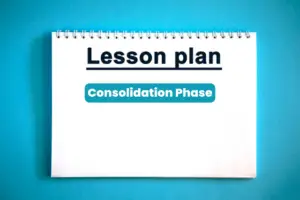This article contains information on the Consolidation Phase of Lesson Plan

Teaching is a very delicate but yet interesting profession for those who are passionate about impacting lives, not for those who see it as a means to an end.
Apart from the basic roles of teachers, there are a series of tasks that make the teaching profession seem like a hectic profession. Such tasks include Lesson Planning and writing of lesson notes.
Prior to my one year compulsory National Service (NYSC) where I was posted to serve as a teacher in a village school, I dreaded teaching so much because of lesson notes, but like they say goes, “never say never.” What I dreaded the most was staring at me in the face.
As a one-time teacher, I realized that a lot of times, there is a mix-up between lesson plan and lesson notes.
Before we delve into the goal of this article, it is important to understand these two terms.
Definition of Lesson Plan and Lesson Note
A lesson plan [1] is a pre-planned daily lesson guide that indicates the activities or what the teacher is planning to teach the students during a particular period, how he or she should teach it, and how to evaluate the learning process.
On the other hand, a lesson note refers to a document, usually handwritten, where the teacher basically indicates the flow of the lesson. Above all, the lesson note shows the impact of teaching on the learners inside a particular classroom.
The main difference between lesson plan and lesson note is that a teacher prepares a lesson plan before the lesson in order to increase the productivity of the lesson, while a lesson note is prepared by the teacher while the lesson is going on in order to measure the level of comprehension of the learners and impact of the lesson on learners.
There are numerous advantages of a lesson plan [4] but having understood the difference between a lesson plan and note, let’s proceed with the goal of this article – Consolidation phase of a lesson plan.
Basically, a lesson plan has 3 phases [2] but over time due to research and discoveries, more phases have evolved. In this article, we will be considering the last phase of a lesson plan which is the consolidation phase.
What is Consolidation Phase of Lesson Plan?
The consolidation phase of a lesson plan refers to the final stage of a lesson where the teacher helps students summarize and solidify their understanding of the key concepts and skills covered during the lesson. This phase is used by teachers to review the lesson objectives and consolidate learning.
In this phase, the learners and teachers can reflect on the learning, ask questions, discuss next steps and celebrate good work and positive learning outcomes. It is a crucial part of the lesson as it allows students to reflect on what they have learned, connect new knowledge to their prior understanding, and try to assimilate the information for long-term retention. This phase also provides an opportunity for the teacher to assess the students’ learning and make adjustments where necessary.
Consolidation is often the final activity before a class moves to the next topic or immediately precedes a final assessment.
In other words, it can be compared with revision.
Key components of Consolidation Phase
The consolidation phase has three key components [3]: Sharing, Highlights and Practice.
Sharing

In the sharing component, students actively engage in discussing and sharing their learning with their peers. This can take various forms, such as small group discussions or whole-class sharing. The purpose of sharing is to provide students with an opportunity to articulate their thoughts, clarify their understanding, and learn from one another.
During this phase, students can discuss key concepts, ask questions, provide examples, or explain their reasoning behind certain ideas. By participating in discussions and listening to their peers, students gain different perspectives and deepen their understanding of the lesson content. Sharing also fosters effective communication skills, collaboration, and active engagement among students.
Highlights
The highlights component involves summarizing the key strategies, ideas, and information from the lesson on anchor charts or other visual aids. The teacher, with the input of students, creates a collective summary of the important points discussed during the lesson. This could be in the form of bulleted lists, diagrams, mind maps, or concept maps.
The process of creating anchor charts helps students identify and prioritize essential information, condense it into concise statements or visuals, and make connections between different ideas. It serves as a visual representation that can be referred back to for reinforcement and review.
Practice:
The practice component in the consolidation phase focuses on providing students with opportunities to apply what they have learned from the lesson with an independent problem.
Practice activities can take various forms depending on the subject and learning objectives. Some effective strategies for practice include:
a. Skill-based Exercises
b. Application Tasks:
c. Formative Assessments:
d. Differentiated Practice: Recognizing that students may have different learning needs and levels of understanding, it is important to provide differentiated practice activities.
Through deliberate and structured practice, students have the chance to reinforce their learning, apply their knowledge, and develop confidence and mastery in the subject matter.
Effective Strategies for the Consolidation Phase
1. Recap and Review:

Start the consolidation phase by recapping the main points covered in the lesson. Encourage students to actively participate by asking questions, summarizing key ideas, or discussing their understanding with their peers.
2. Graphic Organizers:
Graphic organizers, such as concept maps, Venn diagrams, or mind maps, can be effective tools for consolidating information. The teacher can ask students to create visual representations of the lesson content, connecting related concepts, and illustrating their understanding.
3. Summarization Activities:
Engage students in activities that require them to summarize the lesson content in their own words. They can write a summary paragraph, create a bulleted list of key points, or prepare a brief oral presentation to share with their classmates.
4. Application Tasks:
Provide students with real-life or scenarios where they can apply the knowledge and skills they have learned. This can be in the form of problem-solving activities, case studies, or role-playing exercises. By applying their knowledge, students deepen their understanding and see the relevance of what they have learned.
5. Peer Teaching:

Encourage students to teach or explain the lesson content to their peers. Pair or group students and assign each group a specific topic or concept from the lesson. They can create mini-lessons, presentations, or interactive activities to teach their classmates. Peer teaching promotes active engagement and reinforces understanding.
6. Formative Assessment:
Use formative assessment techniques to evaluate students’ learning during the consolidation phase. This can include quizzes, or short written responses.
PowerPoint quizzes are also a popular option. Your class must work together to decide on the correct answer, using the knowledge they have gained and reinforcing the lesson.
Analyzing the results of these assessments will help you identify areas where students may need additional support or clarification.
7. Closure and Reflection:
End the consolidation phase by providing closure to the lesson. Summarize the main points once again and allow students to ask any remaining questions. Engage students in a brief reflection activity where they can think about what they have learned, how it connects to previous knowledge, and how they can apply it in the future.
Importance of the Consolidation Phase:
1. Reinforcement of Learning:
The consolidation phase helps reinforce the newly acquired knowledge and skills learned during a lesson and makes sure none of the students are left uncertain. By reviewing and summarizing the lesson content, students are given the opportunity to revisit important concepts. As a teacher, this gives you the chance to clarify aspects of the lesson, answer any questions your students have and revisit your lesson objectives
2. Reflection and Metacognition:
Consolidation encourages students to reflect on their learning process. It enables them to think about what they have learned, how they learned it, and how they can apply the knowledge in different contexts. This reflection promotes metacognitive skills, which are essential for independent learning.
3. Assessment of Learning:
The consolidation phase provides teachers with an opportunity to assess students’ understanding and identify any misconceptions or gaps in knowledge. It allows teachers to gauge the effectiveness of their instruction and make any necessary adjustments for future lessons.
4. It Creates Room for a Supportive Learning Environment
The classroom is made up of learners with different learning and mental capacities. The consolidation phase helps to understand that learning styles differ for different children and the knowledge of this curbs the stigma and shame some children feel about not ‘getting a topic’ straight away by giving them opportunities and encouragement to ask questions and engage with the lesson topic.
This helps to create an open and supportive learning environment where students feel confident to speak up and ask for further explanation on a topic.
5. Information Retention
Consolidation also helps with information retention, student confidence and creating well-rounded lesson plans that meet your class’ learning objectives.
Conclusion
Remember, the consolidation phase should be tailored to the specific needs of your students and the subject matter being taught. It is important to create a supportive and inclusive environment where students feel comfortable asking questions, sharing their understanding, and engaging in meaningful discussions. By implementing effective consolidation strategies, you can help students solidify their learning, promote deeper understanding, and enhance their overall academic growth.
Lastly, there are many forms consolidation can take in the classroom. It could be:
- A lesson summary
- A final call for questions on the topic before the lesson ends
- An interactive PowerPoint quiz
- A game, etc.
References
[1] Anuradha. “What Is the Difference between Lesson Plan and Lesson Note.” Pediaa.com, 3 Jan. 2022, https://pediaa.com/what-is-the-difference-between-lesson-plan-and-lesson-note/amp/.
[2] “No Title.” Twinkl.Co.Za, https://www.twinkl.co.za/teaching-wiki/phases-of-a-lesson-plan.
[3] “Three-Part Lessons.” Kelly Little’s Math Portfolio, https://kfergusonmath.weebly.com/three-part-lessons.html.
[4] Mizanurrmizan.Info, https://www.mizanurrmizan.info/what-is-lesson-plan-concept-definition-steps-and-importance-of-lesson-plan/.
Don’t miss out on current updates, kindly like us on Facebook & follow us on Follow @EAfinder OR leave a comment below for further inquiries







